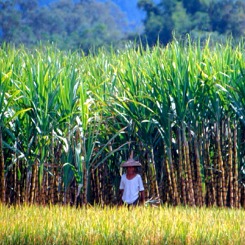



While visiting Tongxiang, a county-level city in Zhejiang south of Taihu Lake, the view from my hotel window was of farming on plots of land surrounded by low-rise apartment buildings. I had often seen this across Southern China, where rapid urban growth was swallowing farmland. In earlier days, the relationship between rural and urban communities was much clearer. Today with urbanization, supermarket shopping has increasingly seen traditional markets disappear.
My interest in the landscape and of the urban-rural relationship comes from my background as a geographer. In 1987 my initial impressions of China were of how different it was to my homeland, Scotland. The landscape was much more diverse than I had expected. Agricultural patterns and activities along with village architecture would change both steadily and radically. This was a response to climate, water availability, the terrain, whether flat or sloping, and fertility of the soil.
I was transfixed by the beauty of the landscape without experiencing the hardships associated with country life. Even looking from a train though, it was obvious that considerable human labor was required for the harvests.

Since 1987, my journeys have taken me through and across many of China’s landscapes. Such is the sheer size of China that what represents rural life in Inner Mongolia autonomous region is so totally different to, say, Hainan Island. So cold are the northern winters that any form of arable farming remains highly seasonal, with long periods of inactivity. In contrast, some southern regions are under cultivation all year round.
Climate similarly affects building styles and strengths of domestic dwellings. In the far north of Heilongjiang, keeping warm, when outside temperatures may linger around -20 C below for several months, is a priority, Yet as I walked through parts of parts of Xishuangbanna in Yunnan, the priority was protection from heavy summer rains or intense sunlight.
Water of course is a significant influence. While eastern coastal and southern areas have abundant or at times too much water, we do not need to go far west of even Beijing to see how dry the land becomes. Flying from Shanghai towards Xinjiang can be revealing. The maze, the patterns of lights produced by many clusters of cities, towns and villages around the Yangtze River Delta, start to thin out beyond Anhui, partly due to the plains giving way to mountain ranges. Far fewer large cities exist between Xi’an and Lanzhou before the long flight above the Hexi Corridor along which the Silk Road once followed. Below there is virtual darkness broken occasionally by faint glimmers of light.
Gansu’s Dunhuang is a perfect example. I recall a daylight flight from Xining, capital of Qinghaim up to Lhasa in Tibet. While a few small settlements gathered around Qinghai Lake after Golmud, it was increasingly devoid of urbanization – a fantastic journey but also one emphasizing the country’s demographic imbalance.
Looking at maps it was obvious that the vast majority of China’s population concentrates to the eastern and southern fringes with only a few interior clusters such as Chongqing rising above the Yangtze. This imbalance of course reflects with infrastructure availability. While in the east there are many rail lines to chose from, heading overland in 1997 from Lanzhou to Urumchi there appeared only one.

In 1992 I began work in Guangzhou. With arable farming going on right outside my workplace, it was so easy to go out and walk amidst vegetables, watching planting, cultivation, harvesting and even heading off to nearby markets. Today that is just a distant memory.
Although I returned to Scotland in mid-1993, I came back to China at every opportunity to explore more of the incredible Chinese countryside. These lands were often away from popular tourist routes, such as along the course of the Yangtze River, then part of Sichuan. The uplands of Yunnan, close to Tibet, let me cycle across high-plateau grasslands where black-coated yaks grazed. In 1997 my travels led right out across the deserts of China’s northwest to the Tianshan Mountains of Xinjiang.
At that time, there was an obvious presence of young people around the rural villages, with much farming requiring considerable labor. Recent visits to parts of Shanxi showed a quite different scene of a more elderly population. The youth of the countryside had been steadily drifting off to cities in search of work and hopefully success, which some did find, particularly in the earlier days of reform and opening-up.
As I travel around China I often look from the train window and think of not only the future of rural lands but also of the many wonderful memories from my earlier days of exploring them. Many of these times came when China still had a large and active population living in villages. Opportunities thankfully still arise to visit rural districts that would have been hard to reach or even find, such as Guizhou near Zunyi and Tongxiang in Zhejiang.
It is obviously difficult to encourage the young to move back from modern cities to rural lands. It is equally difficult to provide the range of services, such as schooling. Young people will continue to move to larger centers for education. I personally witnessed this while living and working in Guangzhou in the early 1990s. Many of my students had come from towns and villages across Guangdong to my college, some of them with the natural ambition of living in dynamic urban cores.
Much has been done to stabilize rural populations and improve living conditions. In many areas new roads are upgrading connectivity between villages and nearby towns. Better access allows urban residents to drive to farming villages for weekend home stays and rural life experiences.
There is much more to say about how the countryside can be developed sustainably, which as both a geographer and traveler I have been thinking a lot about recently. Certainly some of my finest moments in my China journey have been experiencing firsthand rural landscapes.











If you have any problems with this article, please contact us at app@chinadaily.com.cn and we'll immediately get back to you.